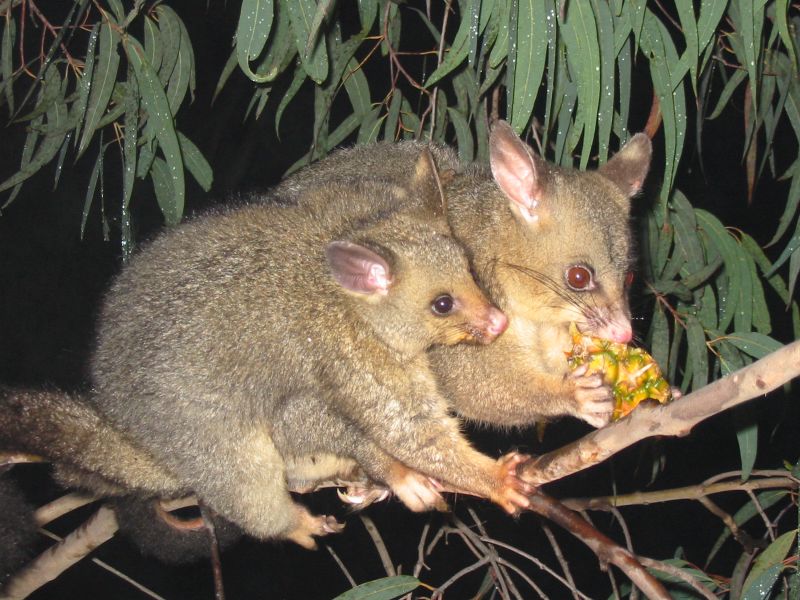ERROR : Server Busy(-1105)
ERROR : Server Busy(-1105)
Common Brushtail Possum (Trichosurus vulpecula) - Wiki
Common Brushtail Possum
From Wikipedia, the free encyclopedia
[Photo] Common Brush Tailed Possum (Trichosurus vulpecula). Found on Flickr, by wollombi http://flickr.com/photos/wollombi/58499575/ Date: 1 November 2005
The Common Brushtail Possum (Trichosurus vulpecula, from the Greek for "furry tailed" and the Latin for "little fox") is the largest possum, and the Australian marsupial most often seen by city-dwellers, since it is one the very few that thrives in cities as well as a wide range of natural and human-modified environments. Despite its resemblance to a fox's brush, the characteristic tail is prehensile and is naked on its lower underside.
Like most possums, the Common Brushtail is nocturnal. It is mainly a folivore, but supplements its usual diet of leaves with fruit, invertebrates, flowers, buds, and whatever else is available (including the eggs of New Zealand's native birds, and sometimes even the young chicks). In most Australian habitats, leaves of Eucalyptus are a significant part of the diet but rarely the sole item eaten. This is probably because of the tannins and other chemical defences present in eucalypt leaves. Around human habitations, Common Brushtails are inventive and determined foragers with a liking for fruit trees, vegetable gardens, and kitchen raids.
They are highly inquisitive and live in troupes of about a dozen individuals with a complex social structure not dissimilar from wolves and primates.
During the day, Common Brushtails sleep in a den in a hollow tree or any other convenient place, notably ceiling spaces that are not securely sealed. Although primarily aboreal and not found in places without trees to provide refuge, they spend a good deal of time on the ground. They are able to stand upright.
The very loud hissing, crackling territorial call of the male Common Brushtail has a harsh quality. They have a number of other vocalizations, mainly consisting of pitched clicks. Most are also relatively quiet. Socially they may be solitary or they may form small groups which share territory.
Although prohibited in many areas, Common Brushtail possums make excellent pets if they are given sufficient forested space. They are easy to feed with the vegetarian part of a human diet making a fairly complete possum diet.
European settlers aiming to establish a fur industry introduced the Common Brushtail to New Zealand, where there are now about 60 million Common Brushtail Possums. Their introduction has been ecologically damaging because the native vegetation has evolved in the absence of mammalian herbivores. The possums do particular damage to broadleaved trees, notably rata, leading to canopy collapse and potentially competing for food with native forest birds. They do not have so much impact on Southern Beech (Nothofagus), but their presence tends to reduce the species diversity of Nothofagus forest since they eat many of the other species that would naturally be present. They are said to prey on bird eggs and chicks by New Zealand farm forestry interests. Possums are also said to be vectors of bovine tuberculosis which provides a major threat for cattle and farmed deer although the transmission path has not been discovered nor proven to even exist. Attempts to reduce numbers by trapping and poisoning have had only short-term success, and the poisons used, usually sodium monofluoroacetate (1080) or cyanide are environmental hazards in themselves resulting in many consumers avoiding food exports from New Zealand due to such contamination.
To prevent damage to young trees it seems to be necessary to keep numbers very low, perhaps 5% of the levels that would be reached without interference. The possum is widely regarded in New Zealand as a major ecological threat, and some forestry industry funded ecological organisations such as the Ecologic Foundation encourage its elimination; however its impacts are compounded by those of other introduced species such as Red Deer and goats, not to mention human activities such as agriculture, forestry, and mining. The New Zealand Department of Conservation is the largest single agency involved in possum control and much possum control is also carried by councils and regional authorities to combat the threat of bovine tuberculosis. A small fur industry was developed, and possum trapping and shooting continues to the present day, and the fur is often sold as 'eco-fur'. The numbers of animals take for fur is significant in relation to the numbers killed in poisoning. Environmentalists question whether the industry is compatible with the aim of drastically reducing or eliminating possums.
The Common Brushtail Possum has also been introduced to North America and possibly the Eurasian continent. Environmental effects have so far been relatively minor perhaps due to the presence of predators that prevent population densities from becoming excessive.
http://en.wikipedia.org/wiki/Common_Brushtail_Possum
| The text in this page is based on the copyrighted Wikipedia article shown in above URL. It is used under the GNU Free Documentation License. You may redistribute it, verbatim or modified, providing that you comply with the terms of the GFDL. |
|

